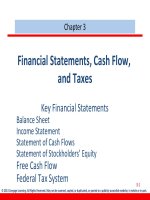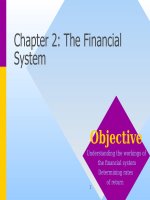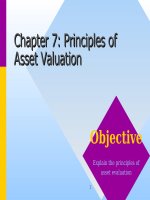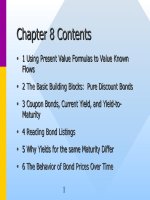Corporate finance chapter 03 interpreting finacial statements
Bạn đang xem bản rút gọn của tài liệu. Xem và tải ngay bản đầy đủ của tài liệu tại đây (348.36 KB, 38 trang )
Chapter 3: Interpreting
Financial Statements
Objective
1
Contrast Economic and
Accounting Models
<=>
Value of Accounting
Information
Copyright © Prentice Hall Inc. 2000. Author: Nick Bagley, bdellaSoft, Inc.
Financial Statements Review
– Financial Statements Provide:
• current and historical information to owners
and creditors
• a convenient way for owners and creditors to
set performance targets
• a convenient standard template for financial
planning
2
Chapter 3 Contents
• 3.1 Functions of Financial
Statements
• 3.6 Analysis Using Financial
Ratios
• 3.2 International Differences
in Accounting
• 3.7 The Financial Planning
Process
• 3.3 Market values v. Book
Values
• 3.8 Constructing a Financial
Planning Model
• 3.4 Accounting v. Economic
Measures of Income
• 3.5 Return on Shareholders v.
Return on Equity
• 3.9 Growth & the Need for
External Financing
• 3.10 Working Capital Mgnt.
• 3.11 Liquidity & Cash Mgnt.
3
3.1 Functions of Financial
Statements
• Financial Statements:
– Provide information to the owners & creditors of a firm
about the current status and past performance
– Provide a convenient way for owners & creditors to set
performance targets & to impose restrictions of the
managers of the firm
– Provide a convenient templates for financial planning
4
3.2 Review of Financial
Statements
5
The Balance Sheet
• Summarizes a firms assets, liabilities, and owner’s
equity at a moment in time
• Amounts measured at historical values and
historical exchange rates
• Prepared according to GAAP, Generally Accepted
Accounting Principles
– GAAP modified occasionally by the Financial Accounting
Standards Board
• Exchange-listed companies must comply with
Securities and Exchange Commission (SEC) rules
6
The Balance Sheet
• Major Divisions:
– Assets
• Current assets (less than a year)
• Long-term assets (longer than a year
– Depreciation
– Liabilities and Stockholder’s Equity
• Liabilities
– Current Liabilities
– Long-term debt
• Equity
7
GPC Balance Sheet at Dec 31, 2xx1
2xx0
Assets
Cash & mkt'ble secs
Receivables
Inventories
*Current assets
2xx1
Change
100.0
50.0
150.0
300.0
120.0
60.0
180.0
360.0
20.0
10.0
30.0
60.0
400.0
(100.0)
300.0
490.0
(130.0)
360.0
90.0
(30.0)
60.0
**Total Assets
600.0
720.0
120.0
Liabilities & Equity
Accounts payable
Short-term debt
*Current liabilities
60.0
90.0
150.0
72.0
184.6
256.6
12.0
94.6
106.6
Long-term debt
**Total liabilities
150.0
300.0
150.0
406.6
106.6
Paid-in capital
Retained earnings
*Shareholders equ
200.0
100.0
300.0
200.0
113.4
313.4
13.4
13.4
Liab + Shareholder
600.0
720.0
120.0
Pp&e
Acc depreciation
*Net pp&e
8
The Income Statement
• Summarizes the profitability of a
company during a time period
• Major Divisions:
– Revenue & cost of goods sold
» Gross margin
– General administrative and selling expenses (GS&A)
» Operating income
– Debt service
» Taxable income
– Corporate Taxes
» Net income
9
The Income Statement
• Important Reminders:
– Retained earnings are not added to the cash
balance in the balance sheet, but are added
to shareholder’s equity
– Accounts show historical values, not market
values.
• The shareholder’s equity may be much higher
or lower than the market value of the firm.
– The value of the firm’s land may have halved or
doubled, but this would not be reported in the
balance sheet
10
GPC Income Statement
for Year Ending 2xx1
Sales revenues
Cost of goods sold
*Gross margin
200.0
(110.0)
90.0
Gen sell, & admin exp
*Operating income
(30.0)
60.0
Interest expense
*Taxable income
(21.0)
39.0
Income tax
*Net income
(15.6)
23.4
Allocation to divs
*Chg retained earn
(10.0)
13.4
11
The Cash-Flow Statement
• Show the cash that flowed into and from a
firm in during a time period
– Focuses attention on a firm’s cash situation
• A firm may be profitable and short of cash
– Unlike the balance sheet and income
statement, cash flow statements are
independent of accounting methods
• The IRS uses accounting income to compute
tax, so accounting rules have a second order
effect on cash flows through taxes
12
GPC Cash Flow Statement, for
the Year ending Dec 31, 2xx0
Net income
+ Depreciation
- Increase in acc rec
- Increase in invent
+ Increase in acc rec
*Total cash from operations
23.4
30.0
(10.0)
(30.0)
12.0
25.4
- Invest in new ppe
*Cash flow invest' activities
(90.0)
(90.0)
-Div paid
+ Inc short-term debt
*Cash flow from financing
(10.0)
94.6
84.6
**Chng cash & mkt securities
20.0
13
GPC Income Statement
for Year Ending 2xx1
Sales revenues
Cost of goods sold
*Gross margin
GPC Balance Sheet at Dec 31, 2xx1
2xx0
Assets
Cash & mkt'ble secs
Receivables
Inventories
*Current assets
Pp&e
Acc depreciation
*Net pp&e
**Total Assets
2xx1
Change
100.0
50.0
150.0
300.0
120.0
60.0
180.0
360.0
20.0
10.0
30.0
60.0
400.0
(100.0)
300.0
490.0
(130.0)
360.0
90.0
(30.0)
60.0
600.0
720.0
120.0
Liabilities & Equity
Accounts payable
Short-term debt
*Current liabilities
60.0
90.0
150.0
72.0
184.6
256.6
12.0
94.6
106.6
Long-term debt
**Total liabilities
150.0
300.0
150.0
406.6
106.6
Paid-in capital
Retained earnings
*Shareholders equ
200.0
100.0
300.0
200.0
113.4
313.4
13.4
13.4
Liab + Shareholder
600.0
720.0
120.0
200.0
(110.0)
90.0
Gen sell, & admin exp
*Operating income
(30.0)
60.0
Interest expense
*Taxable income
(21.0)
39.0
Income tax
*Net income
(15.6)
23.4
Allocation to divs
*Chg retained earn
(10.0)
13.4
GPC Cash Flow Statement, for
the Year ending Dec 31, 2xx0
14
Net income
+ Depreciation
- Increase in acc rec
- Increase in invent
+ Increase in acc pay
*Total cash from operations
23.4
30.0
(10.0)
(30.0)
12.0
25.4
- Invest in new ppe
*Cash flow invest' activities
(90.0)
(90.0)
-Div paid
+ Inc short-term debt
*Cash flow from financing
(10.0)
94.6
84.6
**Chng cash & mkt securities
20.0
3.4 Returns to Shareholders
v. Return on Equity
• Recall our definition in Chapter 2 of the
holding period return, and compare this
with the economic measure of income
(
EndPrice − StartPrice ) + CashDividends
Re turn =
StartPrice
EconomicIncome $ − 2.8Million
=
=
= −1.4
StartPrice
$200Million
• This is the Total Shareholder Return
15
Returns to Shareholders v.
Return on Equity (Continued)
• Traditionally, corporate performance has
been measured by Return on Equity, ROE
AccountingIncome
ShareHoldersEquity
NetIncome
=
ShareHoldersEquity
$23.4 Million
=
= 7.8%
$300 Million
ROE =
16
Profitability
EBIT
Sales
60
=
= 30%
200
EBIT
Return on Assets (RoA) =
AverageTotalAssets
60
=
= 9.1%
( 600 + 720) / 2
NetIncome
Return on Equity (RoE) =
StockHolder' sEquity
23.4
=
= 7.6%
( 300 + 313.4) / 2
Return on Sales (RoS) =
17
Asset Turnover
Sales
Average Receivables
200
=
= 3.6 Times
( 50 + 60) / 2
Cost of Goods Sold
Inventory Turnover =
Average Inventory
110
=
= 0.7 Times
(150 + 180) / 2
Sales
Asset Turnover =
Average Total Assets
200
=
= 0.3 Times
( 600 + 720) / 2
Receivables Turnover =
18
Financial Leverage
Total Debt
Debt =
Total Assets
406.6
=
= 57%
720
EBIT
Times Interest Earnt =
Interest Expense
60
=
= 2.9 Times
21
19
Liquidity
Current Assets
Current =
Current Liabilities
360
=
= 1.4 Times
256.6
Cash + Receivables
Times Interest Earnt =
Current Liabilities
180
=
= 0.7 Times
256.6
20
Market Value
Price Per Share
Price to Earnings =
Earnings per Share
187.2
=
= 8.0
23.4
Price per Share
Market to Book =
Book Value per Share
187.20
=
= 0.6
313.4
21
Ratio Comparisons
• Establish Your Perspective
• Shareholder
• employee, Management, or Union
• Creditor
• Predator, Customer, Supplier, Competitor, Trade Association
• Benchmarks
• Other companies ratios
• The firm’s historical ratios
• Data extracted from financial markets
• Sources
• Dun & Bradstreet, Robert Morris, Commerce Department's
Quarterly Financial Report, Trade Associations
22
Relationships Amongst Ratios
• It is sometimes valuable to decompose
ratios into sums, differences, products
and quotients of other ratios. Many such
schemes start with:
EBIT
EBIT Sales
RoA =
=
*
Assets Sales Assets
= Return on sales * Asset Turnover
23
Illustration
• (Table 3.7 & 3.8 of textbook)
– Consider two firms that are identical except
that Nodebt is financed using $1,000,000 of
equity and Halfdebt is financed using
$500,000 of equity and $500,000 of debt
– further assume that the EBIT of both firms is
$120,000 and tax is 40%
24
Case: Borrow at 10%
EBIT
Interest
Taxable Income
Tax
Net Income
Equity
ROE
Nodebt
Halfdebt
120,000
120,000
0
50,000
120,000
70,000
48,000
28,000
72,000
42,000
1,000,000
500,000
7.20%
8.40%
25









